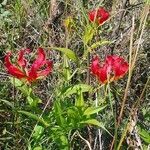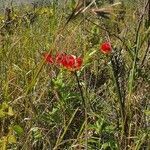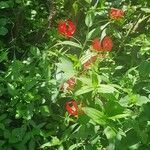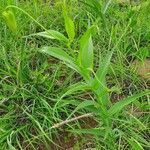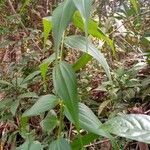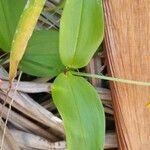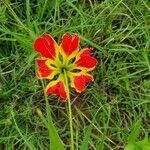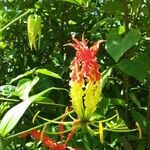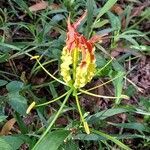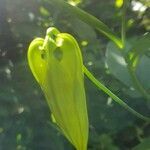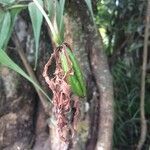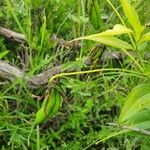A climbing plant. Stems terete, glabrous. Leaves about 10 cm long, 4-8 cm broad, ovate, long-acuminate into a tendril, glabrous. Flowers solitary; buds ovate in outline, winged. Pedicel up to 13 cm long, terete, glabrous, sharply bent at the apex. Perianth-segments at first a pale yellow in colour, changing to red above and yellow beneath when more mature, at first horizontal and then strongly reflexed, 5 cm long, 2 cm broad, lanceolate, acuminate, with a deeply channelled claw, keeled in the channel. Stamens at first pointing downwards, at length becoming horizontal and radiating, 2-7 cm long; anthers 1-2 cm long, 3 mm broad, linear. Ovary 1-7 cm long, deeply 3-lobed; style bent at right angles to the ovary, 3-8 cm long; lobes 3 mm long.
Stems usually climbing to c. 2 m (rarely to 6 m), less often erect; green. Leaves (including the tendril) 8-17.5(-25) by (1.25-)1.5-4(-4.5) cm; tendril usually less than 1 cm long. Pedicels 4.5-19 cm. Perianth segments narrowly elliptic, with undulate or crisped margins, 5-7(-9) by ¾-1.5(-3) cm broad, yellow or red, often (perhaps always in Asia) yellow or green towards the base at first but becoming red throughout later. Filaments spreading, 2.5-5 cm long; anthers 7-10 mm long. Ovary 8-15 mm long; style including the filiform, 3-7(-12) mm long style branches 3.5-5.5 cm long. Capsule 4-10 by c. 1.5-2 cm. Seeds vivid-red or orange-red, with a fleshy testa, c. 5 mm ø, tardily falling.
Climbing or erect geophyte, 0.25-2.43 m high. Corms abruptly bent, tunic lacking. Stems supple, scandent. Leaves alternate or crowded in places, linear to ovate, attenuated into a terminal, recurved tendril. Flowers ± nodding, on upper part of stem on long pedicels, placed beside a leaf or unattended; tepal segments free, equal, narrowly ovate-acuminate, often crisped, persistent, yellow, orange or red. Stamens hypogynous; filaments firm, terete, spreading; anthers 2-thecous, versatile. Ovary oblong; ovules many. Flowering time Nov.-Mar. Fruit a cylindrical capsule, 3-valved, loculicidal, leathery. Seeds globose, bright red, fleshy.
Rhizome usually forked, ca. 1 cm in diam., fleshy. Stem scandent, 2--3 m or more, rather slender. Leaves alternate or occasionally also opposite, sessile or shortly petiolate, lanceolate to ovate-lanceolate, 7--13 cm, apex long caudate with a tendril. Flowers nodding; pedicel 10--15 cm. Tepals reflexed, bright red, proximally tinged with yellow, linear-oblanceolate, 4.5--5 cm × 7--9 mm, base slightly clawed, margin much crisped. Filaments 3--4 cm; anthers ca. 1 cm. Style 2.5--3.5 cm; stigma lobes 6--7 mm. Fl. Jul--Aug. 2 n = 22, 88, 90.
Scrambling and climbing herb to 4 m, with thick rhizomes. Leaves sessile, lanceolate, 6–25 cm long, 1.2–4.5 cm wide; curled apical tendril 1–2 cm long. Flowers 4.5–7.5 cm diam., yellow, orange or red; pedicel 4–20 cm long. Perianth persistent. Sepals and petals 5–8 cm long, 7–15 mm wide, strongly reflexed; margins undulate. Stamens 3–7 cm long; filaments filiform, 2.5–5 cm long, divergent; anthers 7–10 mm long. Ovary glabrous, 1–1.5 cm long; style 3.5–5.5 cm long. Capsule ellipsoid, 4–10 cm long, 1–2 cm diam. Seeds ovoid, 4–5 mm diam.
A scrambling herb. It keeps growing from year to year. It grows 1.5 m long. The leaves are alternate. The leaf tips end in a coiled tendril. The flowers are orange or red and have 6 tepals that curve backwards. There are 6 long stamen that spread out parallel to the ground under the flower. The fruit is a leathery capsule with bright red seeds.
Flowers turning from yellow to red.
Common forest climber
